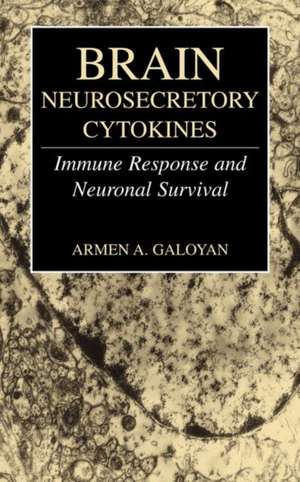Brain Neurosecretory Cytokines: Immune Response and Neuronal Survival
Autor Armen A. Galoyanen Limba Engleză Hardback – 30 apr 2004
| Toate formatele și edițiile | Preț | Express |
|---|---|---|
| Paperback (1) | 712.09 lei 6-8 săpt. | |
| Springer Us – 25 sep 2012 | 712.09 lei 6-8 săpt. | |
| Hardback (1) | 722.12 lei 6-8 săpt. | |
| Springer Us – 30 apr 2004 | 722.12 lei 6-8 săpt. |
Preț: 722.12 lei
Preț vechi: 760.13 lei
-5% Nou
Puncte Express: 1083
Preț estimativ în valută:
138.18€ • 144.56$ • 114.78£
138.18€ • 144.56$ • 114.78£
Carte tipărită la comandă
Livrare economică 02-16 aprilie
Preluare comenzi: 021 569.72.76
Specificații
ISBN-13: 9780306483370
ISBN-10: 0306483378
Pagini: 188
Ilustrații: VIII, 188 p.
Dimensiuni: 178 x 254 x 18 mm
Greutate: 0.58 kg
Ediția:2004
Editura: Springer Us
Colecția Springer
Locul publicării:New York, NY, United States
ISBN-10: 0306483378
Pagini: 188
Ilustrații: VIII, 188 p.
Dimensiuni: 178 x 254 x 18 mm
Greutate: 0.58 kg
Ediția:2004
Editura: Springer Us
Colecția Springer
Locul publicării:New York, NY, United States
Public țintă
ResearchCuprins
1 Neurosecretion of Cytokines by N. Paraventriculars and N. Supraopticus of Hypothalamus.- 1.1 The Isolation of Neurosecretory Granules from Bovine Hypothalamus and Neurohypophysis: Bio Assay Methods of Cytokine Identification.- 1.2 Identification of interleukins 1? and 1? in the Lysates of Neurosecretory Granules of Bovine Neurohypophysis and Hypothalamus.- 1.3 Identification of IL-2 in the Neurosecretory Granules of Bovine Neurohypophysis and Hypothalamus.- 1.4 Identification of IL-6 in the Neurosecretory Granules of Bovine Neurohypophysis.- 1.5 Identification of Tumor Necrosis Factor ? (TNF-?) in the Neurosecretory Granules of Bovine Hypothalamus and Neurohypophysis.- 2 Discovery of New Neurosecretory Cytokines: Proline-Rich Peptides Produced by N. Paraventricularis and N. Supraopticus of Hypothalamus.- 2.1 Isolation of Proline-Rich Peptides from the Neurosecretory Granules of Bovine Neuro-Hypophysis: Primary Structures, Mass-Spectral Characteristics, and Localization.- 2.2 Identification of PRP-1 in the Brain by Immunohistochemical Methods using Polyclonal Antibodies.- 2.3 Determination of PRP-1 in the Thymus, Lymph Nodes, and Heart using Monoclonal Antibodies.- 2.4 Interactions of PRP-1 with Coagulation Cascade Components : A Potential Role For PRP-1 in the Metabolism of Factor Xa/Antithrombin Iii Complex.- 3 interaction of PRP-1 with Cytokines, Hormones, and Neurotransmitters.- 3.1 Effect of PRP-1 and Lysates of Neurosecretory Granules on the Expression of Cytokines in Macrophages and Astrocytes.- 3.2 Effect of PRP-1 on the Expression of interleukins and Prolactin in Different Organs of Mice during Aluminum Neurotoxicosis.- 3.3 PRP-1 increases the Expression and Release of Human Growth Hormone in the Culture of Balb/C Mouse Fibroblasts.- 4 Antibacterial andAntiviral Activity of PRP-1 and Some Immunological Mechanisms of its Action.- 4.1 Effects of PRP-1 on the Survival of Mice infected with Different Strains of Gram-Negative and Gram-Positive Bacteria At Lethal Doses.- 4.2 Effects of PRP-1 on the Growth of Bacteria in the internal Organs of Mice infected with S. typhimurium.- 4.3 Effects of PRP-1 on Anti-Microbial Antibody Production in Mice infected with S. typhimurium and S. cholerae suis in Lethal Doses.- 4.4 Effect of PRP-1 on Bactericidal Activity of Macrophages.- 4.5 Effect of PRP-1 on the Secretion of Interleukin-1 by Peritoneal Macrophages of Mice infected with S. typhimurium in Sublethal Doses.- 4.6 Effect of PRP-1 on the Antigen-Presenting Function of Macrophages in Mice infected with S. typhimurium.- 4.7 Effect of PRP-1 on the Accumulation of Macrophages in Peritoneal Cavities of Mice infected with S. typhimurium.- 4.8 Effect of PRP-1 on the Viability of Macrophages in Mice infected with S. typhimurium.- 4.9 Effect of PRP-1 on interferon-? (IFN-?) Biosynthesis in Human Mononuclear Cells and the Replication of Encephalomyocarditis Virus in Cell Culture.- 5 Prp Regulation of T-Lymphocyte Development and Myelopoiesis.- 5.1 Influence of PRP-1 on interleukin-2-Dependent Functions of Human Lymphocytes in Culture and on the Proliferation of Jurkat Cells.- 5.2 Regulation of Thymocyte Differentiation by PRP-1 in Neonatal and Fetal Thymus.- 5.3 PRP-1 Is a Regulator of Myelopoiesis.- 6 Neuroprotective (Antineurodegenerative) Properties of PRP-1.- 6.1 Protective Effect of PRP-1 Against Snake Venom- induced Neuronal injury.- 6.2 Protective Effect of PRP-1 Against Trauma- induced Central and Peripheral Neuronal injury.- 6.3 Morphological and Biochemical Changes in Brain Microstructure in Crush Syndrome and Effect of Prp.-6.4 PRP-1 Protects Brain Neurons Against Aluminum (Al) Neurotoxicosis (Electron Microscopy Studies).- 7 Effect of PRP-1 on Tumor Cells.- 7.1 Effect of PRP-1 on the Morphology and Mitotic Activity of Neurinoma of Rat Noduli Gasser (NRNG) Cells in Culture (Electron Microscopy Studies).- 7.2 Changes in the Ultrastructure of L929 Tumor Cells Under the Action of PRP-1 in Vitro.- 8 Basic Biochemical Mechanisms of PRP-1 Action in Different Pathologies.- 8.1 Effect of PRP-1 on GFAP Biosynthesis in Astrocyte Culture (Immunocytochemical Data).- 8.2 Effect of PRP-1 on Caspase Activity of Murine Neuroblastoma N2A.- 8.3 Regulation of Membrane Phospholipid Metabolism by PRP-1 in Cardiopulmonary insufficiency.- 8.4 Influence of PRP-1 on Consequences of Ionizing Irradiation in Rats.- Discussion.- Summary.- References.- List of abbreviations.- Acknowledgements.
Recenzii
From the reviews:
"Brain Neurosecretory Cytokines is an excellent book, a veritable goldmine of information, at the cutting edge of neuroscience. It should stimulate ideas for future directions in neuroscience for years to come. This volume should be highly useful for medical libraries, neuroscientists, endocrinologists and graduate students in these fields." (Arthur S. Brecher, TRENDS in Endocrinology & Metabolism, Vol. 16 (6), 2005)
"Brain Neurosecretory Cytokines is an excellent book, a veritable goldmine of information, at the cutting edge of neuroscience. It should stimulate ideas for future directions in neuroscience for years to come. This volume should be highly useful for medical libraries, neuroscientists, endocrinologists and graduate students in these fields." (Arthur S. Brecher, TRENDS in Endocrinology & Metabolism, Vol. 16 (6), 2005)










